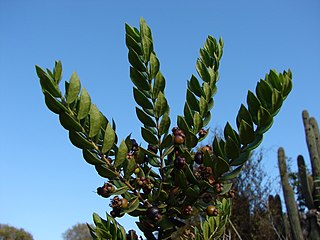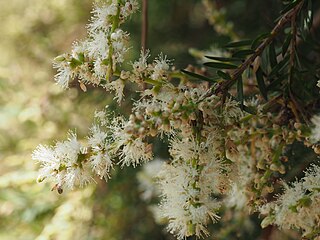
Melaleuca is a genus of nearly 300 species of plants in the myrtle family, Myrtaceae, commonly known as paperbarks, honey-myrtles or tea-trees. They range in size from small shrubs that rarely grow to more than 16 m (52 ft) high, to trees up to 35 m (115 ft). Their flowers generally occur in groups, forming a "head" or "spike" resembling a brush used for cleaning bottles, containing up to 80 individual flowers.

Myrtaceae, the myrtle family, is a family of dicotyledonous plants placed within the order Myrtales. Myrtle, pōhutukawa, bay rum tree, clove, guava, acca (feijoa), allspice, and eucalyptus are some notable members of this group. All species are woody, contain essential oils, and have flower parts in multiples of four or five. The leaves are evergreen, alternate to mostly opposite, simple, and usually entire. The flowers have a base number of five petals, though in several genera, the petals are minute or absent. The stamens are usually very conspicuous, brightly coloured, and numerous.

Myrtus is a genus of flowering plants in the family Myrtaceae. It was first described by Swedish botanist Linnaeus in 1753.

Ugni molinae, commonly known as Chilean guava berry, or strawberry myrtle, is a shrub native to Chile and adjacent regions of southern Argentina. The local Spanish name is murta, and the Mapuche Native American name is "Uñi" or Uñiberry. It is in the same botanical family as the guava, in Myrtaceae.

Backhousia citriodora is a flowering plant in the family Myrtaceae, genus Backhousia. It is endemic to subtropical rainforests of central and south-eastern Queensland, Australia, with a natural distribution from Mackay to Brisbane.

Backhousia is a genus of thirteen currently known species of flowering plants in the family Myrtaceae. All the currently known species are endemic to Australia in the rainforests and seasonally dry forests of Queensland, New South Wales and Western Australia.

Ugni is a genus of plants in the myrtle family Myrtaceae, described as a genus in 1848. It is native to western Latin America from the Valdivian temperate rain forests of southern Chile and adjacent regions of southern Argentina, north to southern Mexico.

Luma chequen, the white Chilean myrtle, is a species of flowering plant in the genus Luma in the family Myrtaceae, native to the central Andes mountains between Chile and Argentina, at latitudes located 30 to 41° South. Synonyms include Eugenia chequen Molina, Myrtus chequen (Molina) Spreng., and Luma gayana (Barn.) Burret. Common names in Spanish include chequén, huillipeta, and arrayán blanco.

Amomyrtus is a genus of flowering plants in the myrtle family, Myrtaceae described as a genus in 1948. It is native to temperate southern South America, where it is distributed in Chile and Argentina.

Backhousia myrtifolia is a small rainforest tree species which grows in subtropical rainforests of Eastern Australia. First discovered and subsequently used by the indigenous communities of Australia, this plant produces oils that have a cinnamon-like aroma, and display both anti-bacterial and anti-fungal properties. Therefore, it has potential applications as not only a spice in food preparation, but also in the medical field as a treatment option for microbial infection. Backhousia myrtifolia can grow up to 30 metres. The leaves are ovate or elliptic, 4–7 cm long, and the flowers star-shaped in appearance.

Melaleuca armillaris, commonly known as bracelet honey myrtle, is a plant in the myrtle family, Myrtaceae, and is native to South Australia, Victoria and Tasmania in south-eastern Australia. It is a hardy, commonly grown species, often used as a fast-growing screen plant, but it also has the potential to become a weed. It has become naturalised in Western Australia and parts of Victoria. In its natural state, it grows on coastal cliffs and along estuaries.

Melaleuca leucadendra, commonly known as weeping paperbark, long-leaved paperbark or white paperbark is a plant in the myrtle family, Myrtaceae and is widespread in northern Australia, Southeast Asia, New Guinea and the Torres Strait Islands. It is a tree, sometimes growing to more than 20 m (70 ft) with a trunk covered with thick, white, papery bark and weeping thinner branches. It has a long flowering season, can flower at almost any time of the year and is often grown as a tree in parks and on roadsides. It was the first melaleuca to be described and was described from a specimen growing in Indonesia.

Myrtus communis, the common myrtle or true myrtle, is a species of flowering plant in the myrtle family Myrtaceae. It is an evergreen shrub native to southern Europe, North Africa, Western Asia, Macaronesia, and the Indian Subcontinent, and also cultivated.

Melaleuca nematophylla, commonly known as wiry honey-myrtle is a plant in the myrtle family, Myrtaceae and is endemic to the south-west of Western Australia. It is one of the showiest melaleucas when in flower in early spring, is easily grown and has unusual needle-like foliage. As a result, it is relatively common in cultivation in temperate parts of Australia.

Austropuccinia is a monotypic genus of rust native to South America with the only species Austropuccinia psidii, commonly known as myrtle rust, guava rust, or ʻōhiʻa rust. It affects plants in the family Myrtaceae. It is a member of the fungal complex called the guava rust group. The spores have a distinctive yellow to orange colour, occasionally encircled by a purple ring. They are found on lesions on new growth including shoots, leaves, buds and fruits. Leaves become twisted and may die. Infections in highly susceptible species may result in the death of the host plant.

Melaleuca decora, commonly known as the white feather honeymyrtle, is a plant in the myrtle family, Myrtaceae and is native to eastern Australia. It is a large shrub to small tree with papery bark, lance-shaped leaves and sweet-smelling, creamy-coloured flowers in summer. It grows in near-coastal forest and swamps in New South Wales and Queensland.

Melaleuca brevifolia, commonly known as mallee honey-myrtle, short-leaf honey-myrtle, or d'Alton's melaleuca is a shrub or tree in the myrtle family, Myrtaceae, and is native to western Victoria, south-eastern South Australia and the south-west of Western Australia. It is a shrub with rough, corky bark and a large number of heads of white to yellowish flowers on the previous season's growth. It is a moderately hardy garden plant.
Backhousia angustifolia, with common name narrow leaf myrtle, is a flowering plant in the family Myrtaceae, native to Queensland and northeastern New South Wales.
Henoonia is a monotypic genus of flowering plants belonging to the family Solanaceae. The only species is Henoonia myrtifolia. It is native to Cuba.